 W
WThe Alpine is a medium to large sized breed of domestic goat known for its very good milking ability. They have no set colours or markings. They have horns, a straight profile and erect ears.
 W
WAmerican Lamancha, or more commonly, simply Lamancha or LaMancha, is a formally recognized breed of dairy goat, first bred in California by Mrs. Eula Fay Frey about 1927. Later she moved the herd to Glide, Oregon for further development. The Lamancha goat is a member of the Capra genus, specifically Capra aegagrus hircus, like all domestic goats.
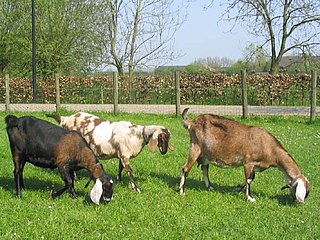 W
WThe Anglo-Nubian is a British breed of domestic goat. It originated in the nineteenth century from cross-breeding between native British goats and a mixed population of large lop-eared goats imported from India, the Middle East and North Africa. It is characterised by large, pendulous ears and a convex profile. It has been exported to many parts of the world, and is found in more than sixty countries. In many of them it is known simply as the Nubian.
 W
WThe Appenzell, French: Chèvre d’Appenzell, German: Appenzellerziege, is a rare and endangered indigenous breed of long-haired white domestic goat from Switzerland. It originates in the "half-cantons" of the historic Appenzell region, Appenzell Ausserrhoden and Appenzell Innerrhoden, and has spread into the neighbouring Canton of St. Gallen.
 W
WThe Beetal goat is a breed from the Punjab region of India and Pakistan is used for milk and meat production. It is similar to the Jamnapari goat and the Malabari goat.
 W
WThe Bionda dell'Adamello is an indigenous breed of domestic goat from the Val Camonica in the province of Brescia, in Lombardy in northern Italy. It takes its name from the massif of the Adamello, part of the Adamello-Presanella subsection of the Rhaetian Alps. It is raised mainly in the Val Camonica, the Val Saviore and the mountains of Brescia; some are found in neighbouring areas of the provinces of Bergamo to the west and Trento to the east. It was in the past known simply as the Capra Bionda or as the Mustàscia.
 W
WThe Capra Grigia, French: Chèvre grise des montagnes, German: Graue Bergziege, is a rare and endangered indigenous breed of domestic goat from Switzerland. It originates in the valleys of the cantons of the Grisons or Graubünden in the eastern part of the country, and of Ticino or Tessin in the south. It is possibly related to the grey type of the Passeirer Gebirgsziege from the Autonomous Province of Bolzano in north-eastern Italy.
 W
WThe Chamois Coloured Goat, French: Chèvre chamoisée, German: Gämsfarbige Gebirgsziege, Italian: Camosciata delle Alpi, is an indigenous breed of domestic goat from Switzerland. It is distributed throughout Switzerland and in parts of northern Italy and Austria, and has been exported to other countries including France. There are two strains, a horned type from the Grisons or Graubünden in the eastern part of the country, and a hornless type from the former bezirk of Oberhasli and the area of Brienz and Lake Brienz in the Bernese Oberland in central Switzerland. In some countries the hornless variety may be considered a separate breed, the Oberhasli goat. The Swiss herd-book was established in 1930.
 W
WThe Danish Landrace is a Danish breed of dairy goat.
 W
WThe Dutch Landrace is a traditional Dutch breed of domestic goat. It has been known in the Netherlands since the seventeenth century, and was formerly numerous there. It came close to extinction in the 1950s, but was saved by cross-breeding with unrelated goats, and by 2020 numbered over 2000 head.
 W
WThe Erzgebirge is a breed of goat native to the Saxony region of Germany. Erzgebirge goats are polled, and have a reddish-brown coat with black stripes on the face, back, and legs. Primarily used for milking, the breed is critically endangered.
 W
WThe Finnish Landrace, also called the Finngoat, is a landrace breed of goat originating in western Finland. The breed can come in a variety of colors but is usually grey, pied, or white, and both horned and polled individuals occur. Finnish Landrace goats are typically used for milking, as there is not a strong tradition of goat meat in Finnish cuisine, unlike in southern Europe. Finngoats are the only breed of goat native to Finland, and originate from native goats crossed with other European imports, especially from Switzerland.
 W
WThe Frisa Valtellinese is an indigenous breed of domestic goat from the province of Sondrio, in Lombardy in northern Italy. It is raised throughout the Valtellina, from which its principal name derives, in the Val Malenco and the upper Val Masino in the Rhaetian Alps, and in the Valchiavenna. It may also be called the Frontalasca, for the village of Frontale, a frazione of the comune of Sondalo in the Val di Rezzalo, or the Rezzalasca for that valley. The name Frisa comes from its frisature, or Swiss markings.
 W
WThe Girgentana is an Italian breed of domestic goat indigenous to the province of Agrigento, in the southern part of the Mediterranean island of Sicily. The name of the breed derives from Girgenti, the name of Agrigento in local Sicilian language. There were in the past more than 30,000 head in the hills and coastal zone of the province. Today, however, this breed is in danger of disappearance.
 W
WThe Golden Guernsey is a rare breed of dairy goat from Guernsey in the Channel Islands, where it has been known for more than two hundred years.
 W
WThe Irish Goat is a traditional Irish breed of domestic goat. It is a dual-purpose breed, used both for meat and for milk. It is an endangered breed, and may survive only in feral populations. It is distinct from the feral Bilberry Goat of Waterford.
 W
WJamnapari is a breed of goat originating from Indian subcontinent. Since 1953 they have been exported to Indonesia where they have been a great success. It is bred for both milk and meat. The name is derived from the Yamuna river.
 W
WKamori is a popular goat breed found in the Sindh province of Pakistan and also found in neighbouring India. They have a distinctive body structure with long ears and neck and a large body, and a distinctive color. The purebred Kamori goat is dark brown with small coffee-colored or dark patches over its entire body. Pure Kamoris are rare and expensive. Kamoris have been crossed with Patairee goats, another breed found in Sindh; hybrids have the Kamori's body structure, but are less expensive.
 W
WThe Kinder is an American breed of domestic goat. It originated on a farm in Snohomish, Washington, where in about 1985 an American Pygmy buck was cross-bred with Nubian does. The resulting stock was selectively bred to create a compact but well-muscled goat, suitable both for milk and for meat production. A herd-book was started in 1988; by 2006 about three thousand head had been registered.
 W
WThe Messinese is an indigenous breed of domestic goat from the area of the Monti Nebrodi and the Monti Peloritani in the province of Messina, in the Mediterranean island of Sicily, in southern Italy. It is raised mainly in those areas, but also in the provinces of Catania, Enna and Palermo. Its range partly overlaps that of the Argentata dell'Etna. The breed was officially recognised and a herd-book established in 2001. It was previously known either as the Capra dei Nebrodi or in general as the Siciliana Comune.
 W
WThe Nera Verzasca, also known as the Nera di Verzasca or Verzaschese, is an indigenous breed of black domestic goat from the Valle Verzasca, in the canton of Ticino in southern Switzerland, from which it takes its name. It is raised in that area and in the provinces of Como, Varese and Verbano Cusio Ossola in northern Lombardy, in the north of Italy.
 W
WThe Nigerian Dwarf is an American breed of dwarf goat. Like the American Pygmy Goat, it derives from the West African Dwarf group of breeds of West Africa.
 W
WThe Oberhasli is a modern American breed of dairy goat. It derives from the subtype of Chamois Colored Goat from the Oberhasli district of the Bernese Oberland in central Switzerland. All purebred members of the breed descend from five Chamois Colored Goats imported to the United States in 1936. A breeder's association was formed in 1977, and a herdbook established in the following year. Until then, goats of this type had been known as Swiss Alpine, and interbred with Alpine goats of other types.
 W
WThe Orobica or Valgerola is a breed of domestic goat from the Val Gerola in the province of Sondrio, in the Bergamo Alps of northern Italy. It is raised in the Val Gerola and the Valchiavenna in the province of Sondrio, in the Alto Lario Occidentale, the Valsassina and the Val Varrone in the province of Como, and in the upper Val Brembana in the Province of Bergamo. The origins of the breed are unknown; it is first documented at the beginning of the twentieth century. The Orobica is one of the eight autochthonous Italian goat breeds for which a genealogical herdbook is kept by the Associazione Nazionale della Pastorizia, the Italian national association of sheep-breeders.
 W
WPayoya is a Spanish breed of goat from the Sierra de Cádiz. It is named after the village of Villaluenga del Rosario, whose inhabitants are known as payoyos. This breed is officially considered to be endangered by the Government of Spain. It is a dairy breed, famous for the payoyo cheese made from its milk since 1997.
 W
WThe Peacock goat breed from the cantons of Graubünden and Upper Tessin in Switzerland is used for the production of milk. There is little known about the origin of the peacock goat. The discovery of the peacock goat was in 1887. The name given to it after the discovery was the striped goat (Pfavenziege), but due to a reporter's spelling error, the goat was known as the peacock goat. The peacock goat also goes by the names of the gray-black goat, the gray-black-white mountain goat, and razza naz. The peacock goat is predominantly white with black boots, while the rear half is mostly black. The goat has a thick mid-length coat of hair. It has large horns, and dark facial spots/stripes from the base of the horn, over the eye, and to the nose which gave the breed their original name, the striped goat.
 W
WThe Pezzata Mòchena, known in Mòcheno as the Pletzet Goes van der Bersntol, is an indigenous breed of domestic goat from the Autonomous Province of Trento, in north-eastern Italy. It originates from the Valle dei Mòcheni, also known as the Valle del Fersina and as the Bersntol, which since the fourteenth century has been home to a Mòcheno-speaking population of Bavarian origin; the breed may for this reason also be called the Valle dei Mòcheni.
 W
WThe Poitou goat is a dairy goat breed from western France. With a history dating back to 1800, the breed is named for the Poitou historic province. Poitou goats are known for their use in goat milk cheese production, though they are an endangered breed, and at one point were down to just 600 breeding animals. Poitou goats have a distinctive appearance: tall and with long, shaggy hair, they are black-brown with white marks on the head and neck, while the underbelly and legs are white.
 W
WThe Pyrenean goat breed from the Pyrenees of France and Spain and the Cantabrian Mountains of Spain is used for the production of milk and meat.
 W
WThe Russian White is a Russian breed of dairy goat. It derives from cross-breeding of the indigenous North Russian with imported Swiss Saanen goats; this began in about 1905. The Gorki derives from it, but is always horned, while the Russian White may be horned or polled. It has become a rare breed, numbering only a few thousand head.
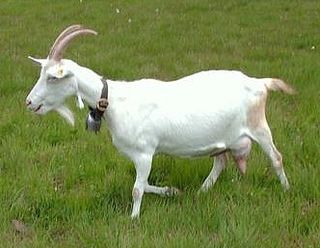 W
WThe Saanen, German: 'Saanenziege', French: 'Chèvre de Gessenay', is a Swiss breed of domestic goat. It takes its name from the Saanental in the Bernese Oberland, in the southern part of the Canton of Bern, in western Switzerland. It is a highly productive dairy goat and is distributed in more than eighty countries worldwide.
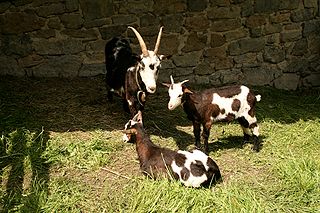 W
WThe Tauernscheck goat breed from Austria is used for the production of milk. It is a very rare breed derived from the Austrian Landrace and Pinzgauer goat breeds.
 W
WThe Thuringian goat breed from Thüringen in central Germany is utilized for the production of milk. It is a variety of the German Improved Fawn goat breed. The Thuringian goat breed is derived from the selective-breeding of crosses between Toggenburg, Harzerziege, Rhönziege, and Thüringer Landziege goat breeds. It is well-adapted to mountainous regions but is almost extinct.
 W
WThe Toggenburg or Toggenburger is a Swiss breed of dairy goat. Its name derives from that of the Toggenburg region of the Canton of St. Gallen, where it is thought to have originated. It is among the most productive breeds of dairy goat and is distributed world-wide, in at least fifty countries in all continents.
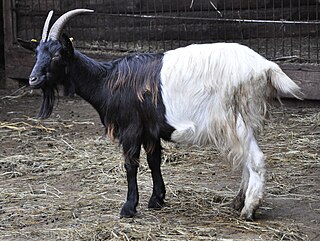 W
WThe Valais Blackneck is a breed of domestic goat from the canton of Valais, in southern Switzerland, and neighbouring areas of northern Italy. The largest concentration is in the area of Visp (Viège). It is present in modest numbers in Austria and Germany. It is known by many names, including German: Walliser Schwarzhalsziege or Gletschergeiss; French: Col Noir du Valais, Chèvre des Glaciers or Race de Viège; and Italian: Vallesana or Vallese.
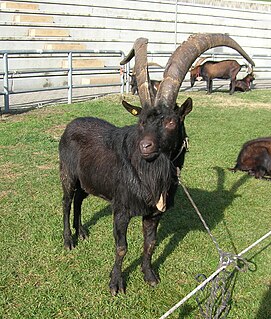 W
WThe Valdostana is an indigenous breed of domestic goat from the autonomous region of Aosta Valley in north-western Italy, from which it takes its name.
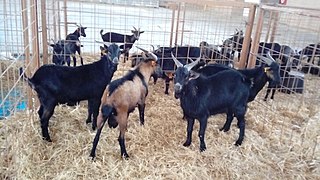 W
WThe Verata is a traditional Spanish breed of domestic goat. It is a dual-purpose breed, reared both for its meat and for its milk. It is named for, and is thought to originate in, the comarca of La Vera, in the province of Cáceres, in the northern part of the autonomous community of Extremadura in western central Spain. It is one of two traditional goat breeds in Extremadura, the other being the Retinta Extremeña.